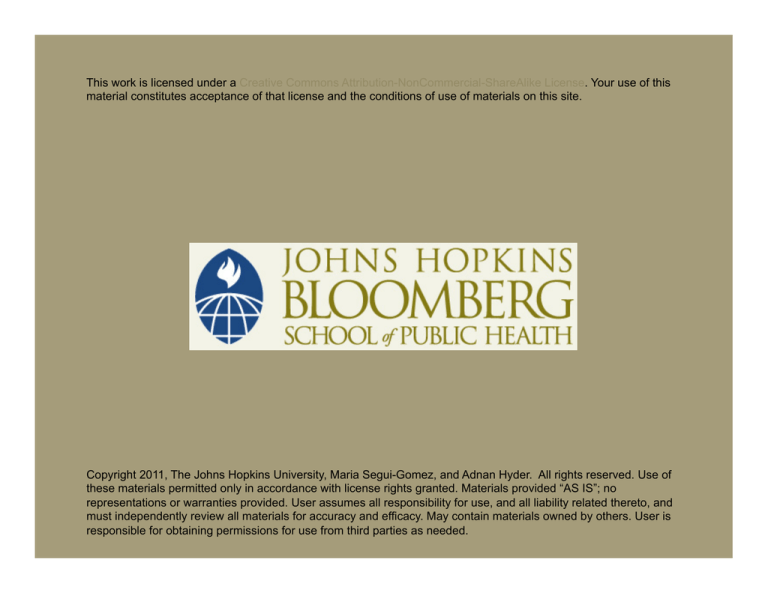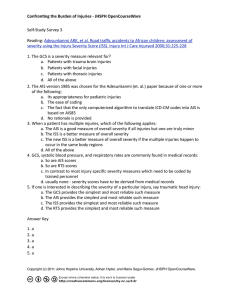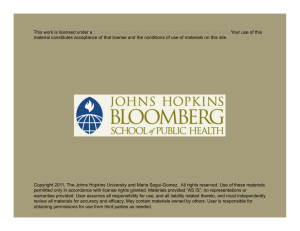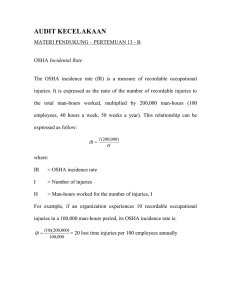
This work is licensed under a Creative Commons Attribution-NonCommercial-ShareAlike License. Your use of this
material constitutes acceptance of that license and the conditions of use of materials on this site.
Copyright 2011, The Johns Hopkins University, Maria Segui-Gomez, and Adnan Hyder. All rights reserved. Use of
these materials permitted only in accordance with license rights granted. Materials provided “AS IS”; no
representations or warranties provided. User assumes all responsibility for use, and all liability related thereto, and
must independently review all materials for accuracy and efficacy. May contain materials owned by others. User is
responsible for obtaining permissions for use from third parties as needed.
Section B: Measuring Exposure
Maria Segui-Gomez, MD, MPH, ScD
What Do We Mean by Exposure?
Practically anything we do
That is, situations where individuals interact with an
environment that can eventually generate energy that could
lead to an injury
- For example, population, distance traveled, hours
traveled, intersections crossed, takeoffs/landings
undergone, hours practicing soccer, minutes spent using
a saw, etc. . . .
3
Relevance of Exposure Data
Exposure is the denominator
Needed for risk calculations
4
An Example
4.1
North America
9.5
Europe
11.4
Middle East
Commercial jet crashes
per million takeoffs/
landings
18.3
Asia
20.6
Eastern Europe
30.2
Africa
32.4
Latin America
0
Source: Enders, K. et al. (1996). Flight Safety Digest, 9.
10
20
30
40
5
Another (Fictional) Example
Country A has fewer child passenger deaths per 100,000
population than country B
Why?
Possible explanations
- Better child restraint use, fewer parents driving
intoxicated, fewer children in cars, etc. . . .
How to look for explanations
6
Country A vs. Country B
Fatalities
Acute care received,
severity of injuries,
frequency, type
7
Country A vs. Country B
Fatalities
Morbidity
Acute care received,
severity of injuries,
frequency, type
Severity of crash,
frequency, type
8
Country A vs. Country B
Fatalities
Morbidity
Events
Acute care received,
severity of injuries,
frequency, type
Severity of crash,
frequency, type
Frequency, type
9
Country A vs. Country B
Fatalities
Morbidity
Events
Acute care received,
severity of injuries,
frequency, type
Severity of crash,
frequency, type
Frequency, type
Exposure
10
How Does It All Come Together? An Example
Children
No
Yes
No
Occupants?
Crashes?
Yes
No
Injuries?
Yes
No
Injury
Yes
No
Hospitalization
Yes
Deaths
Disability
11
Data Sources
When population—census
For all other exposure units—multiple data sources specific to
injury problem and location
In general
- Personal surveys
- Observational studies
- Estimates from goods bought (and average usage)
12
Data Coding
Fragmented
Among the most commonly used are vehicle miles
(kilometers) traveled, derived from either
- Personal diaries/surveys
- National estimates of fuel used and average fuel
consumption per mile
13
Data Coding
Units tend to be big since injuries follow a Poisson
distribution (that is, their frequency is rare)
14
Exposure Data Comparability
Beware of
- Data source variability
- Case inclusion criteria
- Coding system variability
15






